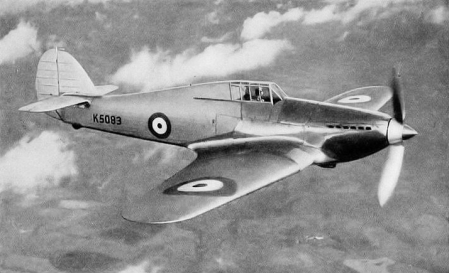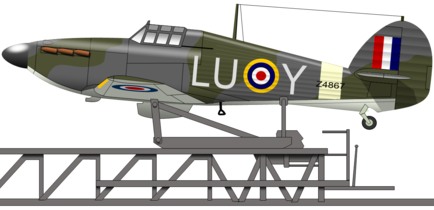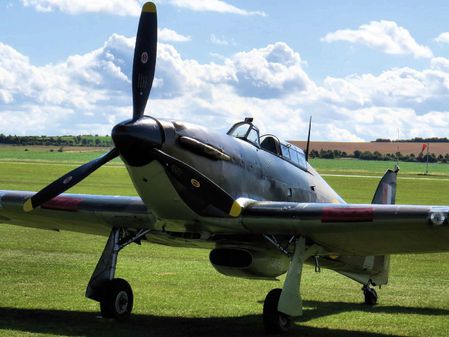
Hawker Hurricane built at Langley
In the mid-1930s, RAF Fighter Command consisted of 13 squadrons equipped with obsolete biplanes such as the Bristol Bulldog, Hawker Demon and Hawker Fury. In 1935, the Air Ministry issued Specification F.36/34 for a new high speed monoplane single seat fighter.
Sydney Camm, chief designer at Hawker Aircraft, who was constantly working on new fighter designs, submitted the prototype of the Hurricane. It was powered by the new Rolls-Royce Merlin engine and designed to carry eight machine guns in the wings.
The prototype, registered K5083, flew in November 1935 and the Air Ministry placed an order for 600 aircraft which was later increased to 1,000. The first production Hurricane, L1547, flew in October 1937.
The prototype was originally referred to as the Merlin
Performance Hurricane prototype K5083
Powerplant 1 x 900hp Rolls-Royce PV-12 driving a two-bladed fixed-pitch propeller
Maximum speed 315 mph at 16,200ft
Ceiling 34,500ft
The aircraft weighed 5,672 lbs and could take off in just under 800 ft. It could climb to 15,000ft in 5 minutes 42 seconds.
In 1936, Hawker Aircraft Ltd bought Parlaunt Farm, Langley, to build an airfield and factory. It was completed by the end of 1938. The factory produced one Hurricane per day but production was up to five per day by 1942.
The Battle of France
In September 1939, The RAF had 18 squadrons of Hurricanes and the first of six squadrons were sent to France to help stem the German invasion. They were joined in May 1940 by four more squadrons but the German Blitzkrieg had gained momentum by now and all the Hurricanes were withdrawn to Britain by the middle of June.
Hurricanes were next involved in Operation Dynamo, the evacuation of British, French and Belgian troops from Dunkirk, and the Battle of Britain which is covered in another page. During the Blitz the Hurricane became the main night-fighter until more specialised aircraft were developed.
The Battle of the North Atlantic
When France fell, a major priority other than the Battle of Britain was the protection of convoys in the North Atlantic. These convoys were bringing desperately needed supplies from North America to Britain and the Soviet Union but, with little or no air cover, they were vulnerable to attack from U-Boats and long-range Focke-Wulf Fw200 bombers.
A stop-gap measure came in the form of Hurricanes launched from a catapult on a merchant ship to intercept the bombers. After the sortie the pilot would then make for nearest landfall or ditch in the sea hoping to be picked up by one of the ships. The aircraft were known as ‘Hurricats’ by the pilots. Later, true Sea Hurricanes were produced, fully equipped to be operated from newly-available escort carriers.
In the desert war in North Africa in 1942, Hurricane MkIIs fitted with four 20mm cannon and provision for two 250 lb bombs proved successful in the ground attack role against German and Italian armour In Europe, Hurricanes flew night-time intruder or ‘rhubarb’ missions flying low over France attacking targets of opportunity such as railway lines and military installations.
A handful of Hurricanes flown by valiant pilots and ground crews defended Malta from June 1940 until early 1942 when reinforcements finally arrived.
In September 1941, two RAF Hurricane squadrons, 81 and 134, were sent to Russia help in the defence of Murmansk. During this deployment the RAF pilots shot down 15 German aircraft for the loss of one Hurricane. Soon after, 2,952 Hurricanes were supplied to the Soviet Union under a Lend Lease agreement.
In 1942 Hurricanes were sent to Asia and fought throughout the war. The machines were becoming obsolete by now and there performance was further hampered by the fitting of tropical air filters under the nose.
14,451 Hurricanes were produced including 2,750 produced by the Gloster Aircraft company, 300 by the Austin Aero Company and 1,551 by the Canadian Car and Foundry, Ontario. Sea Hurricane numbers are a little bit sketchy because many were conversions from machines built as Hurricanes. The best number of custom-built Sea Hurricanes that the author can find is 885.
Other than the UK the Hurricane served the forces of several countries including: Australia, Belgium, Canada, Egypt, Finland, India, Iran, Ireland, New Zealand, South Africa, Soviet Union and Turkey.
Hurricane IIC PZ865
This aircraft was the last Hurricane ever built and wore the inscription ‘The Last of the Many’ below the cockpit as it left Hawkers at Langley.
Performance Hurricane IIC
Powerplant 1 x Rolls-Royce Merlin XX engine
Maximum speed 340mph at 21,000 ft
Range 600 miles
Ceiling 35,600 ft
Armament consisted of 4 x 20mm cannon and provision for 2 x 250 lb or 2 x 500 lb bombs. Only 13 Hurricanes worldwide are maintained in airworthy condition, 6 of which are based in the UK.
The Poppy Appeal
To learn more about the Poppy Appeal, buy products of remembrance or to make a donation that generate funds for the good work of The British Legion please visit:
My name is Gary Flint. I'm author, photographer & illustrator for Postcards from Slough. If you wish to make any comments on the contents of the website please click on the ladybird below:
Gary Flint
08/03/1961 - 09/04/2019
Postcards from Slough is an independently funded website. We are open to offers of sponsorship from companies that have any connections to the town. To contact us please click on the ladybird below:
Chalvey Community Forum
Postcards from Slough is linked with a local action group the Chalvey Community Forum. The group liaises with various local organisations in order to improve the quality of life for residents in the ward of Chalvey and Salt Hill. To learn more please click on the maidenhair leaf below:
Museum of Berkshire Aviation
I volunteer as a guide at the Museum of Berkshire Aviation. It is a special museum and if you would like to know more about the museum then please click on the motif below:
To learn more about the museums activities while staying within this website click on the tab at the top of the page or on the motif below:
Graces Guide
Postcards from Slough uses some images from Grace's Guide. Click on the button below:
British Listed Buildings
Postcards from Slough contributes material to British Listed Buildings and uses the site for cross referencing purposes. Click on the button below:















